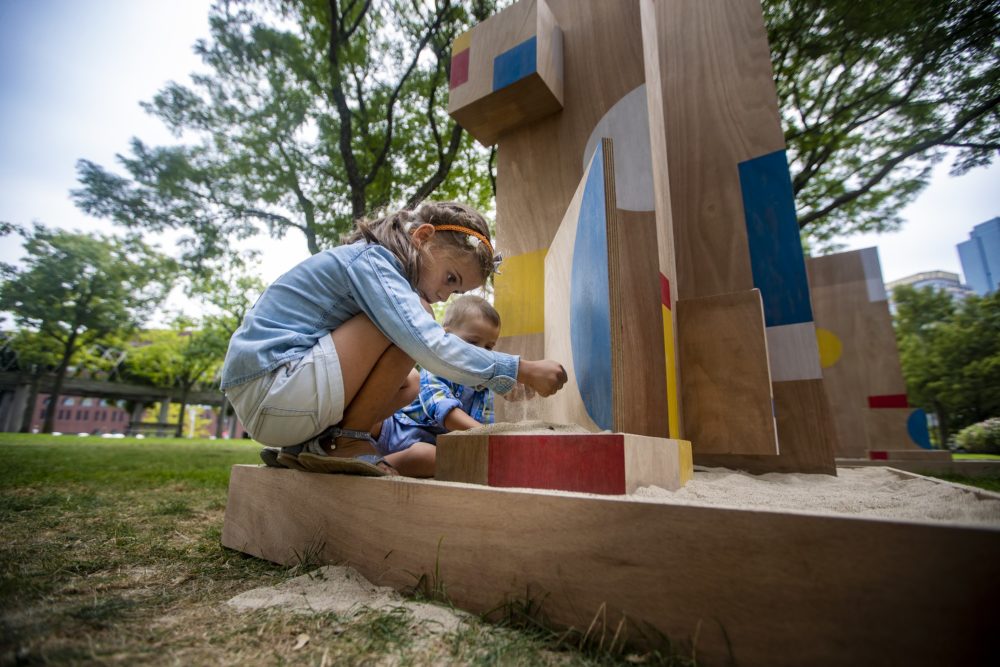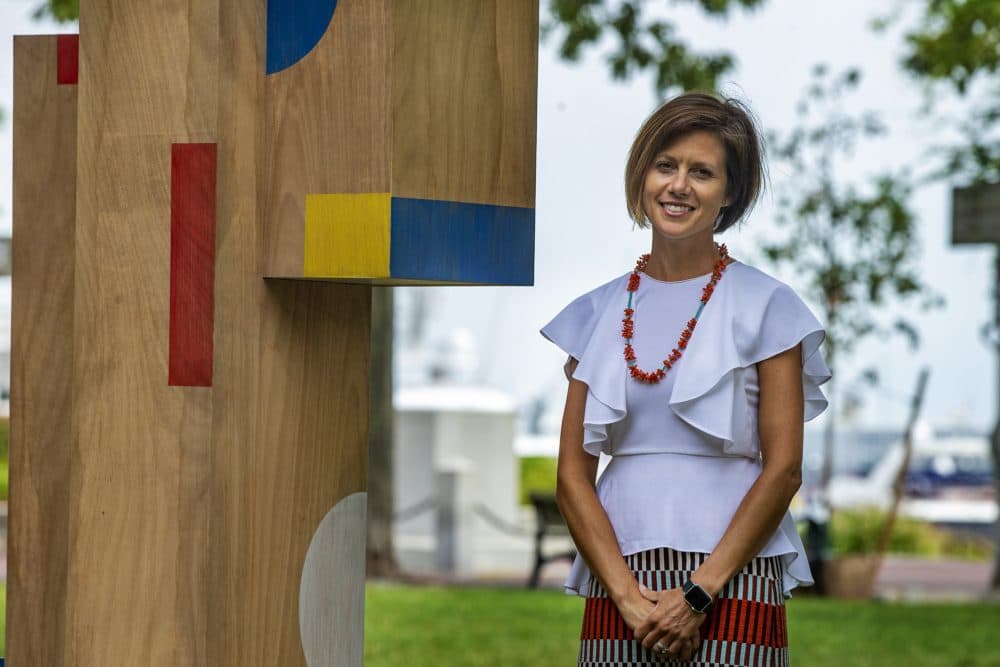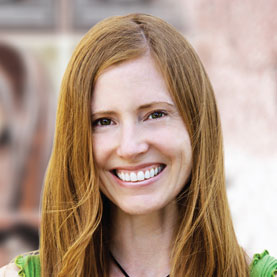
“Do you feel free to play?” That’s a question raised by a new public art installation in Christopher Columbus Waterfront Park on Boston Harbor. The interactive multimedia work was conceived before the pandemic, but now it’s taken on new meaning in a dramatically different time.
Walk into the park entrance on the North End’s edge near the Greenway, and you’ll encounter a grouping of different-sized rectangles and squares made of thick, untreated plywood sitting in the grass. There are six sculptures in all. Each one is set in a box filled with sand, “that you can see has been moved around a lot by children,” Kate Gilbert pointed out with a happy laugh. She’s executive director of Now + There, an organization that produces site-specific, temporary artworks in Boston. This one is called “The Shape of Play.”
Gilbert has observed how children are drawn to the circles, squares, and triangles that are painted on its blond surfaces in primary colors. They evoke the clean, minimalist lines we see in modernist art and design.
Twice an hour a dreamy, 16-minute soundscape floats out of speakers hidden inside the sculptures. “It sounds like something out of like a fairy tale story,” Gilbert mused.
While the installation is whimsical it isn’t just for kids. It’s actually an examination of what play – and playgrounds – mean to society. “Everyone relates to a playground,” Gilbert explained, “everyone’s either been in one as a child, and a lot of parents have spent many hours in playgrounds.”

Gilbert’s partnering group, the Jewish Arts Collective (JArts), originally commissioned “The Shape of Play”for last Passover as a meditation on Judaism’s progressive themes of freedom. The team set out to create a work that would inspire adults to stop, notice their surroundings and then take the experience further by reflecting on who’s free to play in this world and who isn’t.
“A sense of feeling free enough to play – free and safe enough to play – is something that tends to be overlooked,” artist Sari Carel said, “but it is really an essential ingredient to having play that is enjoyable, enriching and nourishing.”
A sense of feeling free enough to play – free and safe enough to play – is something that tends to be overlooked, but it is really an essential ingredient to having play that is enjoyable, enriching and nourishing.
Sari Carel
As a mother of two young girls Carel has spent countless hours on New York City playgrounds, where she lives. “I can’t spend as much time as I would like in the studio,” she said during our interview on Zoom, “and so I would say that I do a lot of my work in my head as I’m sitting in places like playgrounds – spaces where I am a parent and not primarily an artist.”
Carel began thinking deeply about the lessons we can learn from playgrounds while watching her kids . She calls playgrounds places of “serious wonder” that are often dismissed because they’re where children and caregivers while away their time.

Carel also trained her ears on the vibrant sounds of kids at play and urban life swirling around playgrounds. After winning this commission she and her curator braved the January cold for field recording expeditions in Mattapan and other areas of Boston, Newton and Cambridge.
“We went into different playgrounds,” Carel recalled, “and really just explored with our hands, our feet, making sound from different materials – with sticks, stones, sand.”
In a way, Carel played the playgrounds like instruments, then wove their percussive music together for the soundtrack that she said influenced what the physical installation would ultimately look like.
For the commission Carel also studied playground design and researched the role active play has in human and even animal development. But as the piece was finally coming together the pandemic shutdown the subjects of her explorations.
“Seeing those padlocked playgrounds became like a real resonant image for me, and one that really kind of crystallized a lot of things about the experience of this pandemic,” she said.
Carel felt the need for playgrounds – and for art that’s outside and accessible – felt more urgent than ever. “These spontaneous interactions, you know, they’re really so meaningful after we’ve been isolated from each other,” she reflected, “and maybe we didn’t even realize that make our life that much more joyful and interesting.”

At the park a family of five stumbled on “The Shape of Play.” Three young children plunged their hands into the sandboxes and beckoned Taylor Young and Jeremy Bullerous to come play. They were on a day trip to Boston from Ware, Massachusetts.
“I thought it was a playground,” Bullerous said laughing, “Because we were over there running around with the kids.” It was the colors that drew him in.
Making sand castles and sand cakes with her daughter outside on a beautiful day was great for Young who’s been isolating at home during the pandemic.
“It’s definitely like a cooped up environment lately,” she said. “You can’t have school for the kids and kids can’t really interact with each other. So, I think this is nice.”
Bullerous called it a bonus that this encounter is also a piece of public art.
“It’s kind of cool for Boston,” he said, “And the kids, at this age, it sparks their interest – they don’t know it’s artwork yet, you’ve got to teach them that stuff.”
It pleases Kate Gilbert to see the work surprise the parents too, because she said play is critical not only for kids, but for adults. She acknowledged how these days it can be hard to feel free to play when the world feels so heavy and freedom – which is a right – is having a reckoning.
“You know, we all feel we need to be doing more to make the world a more just and equitable place. And in order to do that we also need to be taking care of ourselves and imagining new futures,” she said. Gilbert added imagination – and playgrounds – are fundamental for raising human beings who know how to play well with others.
A reminder of the fight for racial freedom stands just a stone’s throw from “The Shape of Play.” The beheading and eventual removal of the Christopher Columbus statue from the waterfront park happened during the pandemic as “Shape of Play” was in its final phases of creation. Gilbert said another unplanned dialogue has been sparked between the now empty plinth where the monument once stood and Carel’s boxy sculptures.
“We’ve had to bring in this conversation about who are spaces are named for, who makes them, what is publicness right now, and who gets to shape that,” Gilbert said. “The work always had an underlying connection to freedom, but certainly we weren’t thinking of public statuary and the naming of parks when we were commissioning this.”
A series of public conversations are planned to talk about themes of oppression, public space and the history behind the park that’s on land once occupied by Native Americans. The installation’s team has chosen not to use the name Christopher Columbus when referencing the park, and are instead referring to the artwork’s location as Waterfront Park, taking this simple-on-the-surface looking art work to yet another level its creators never imagined when they first conceived it.
The installation “Shape of Play” is on view through Oct. 31.
This segment aired on September 23, 2020.
Support the news







+Join the discussion